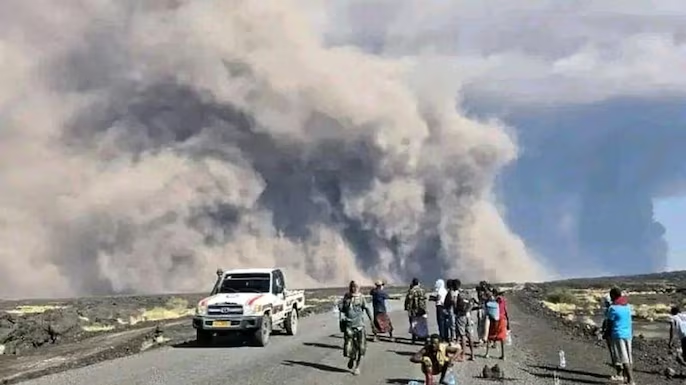Ethiopian volcano eruption shows how one blast can echo across continents.

The Hayli Gubbi volcano in Ethiopia erupted on 22 November 2025, sending massive ash plumes into the atmosphere and triggering global alerts. The eruption’s impact was felt far beyond East Africa as ash clouds drifted across regions, even reaching India at high altitudes. According to the Indian Meteorological Department (IMD), the ash passing over Indian skies is expected to clear completely by this evening, bringing an end to minor visibility disturbances.
Ethiopian volcano eruption
A massive volcanic eruption in Ethiopia has triggered widespread global attention after ash clouds from the Hayli Gubbi volcano drifted across international borders, influencing flight paths, climate conditions, and air quality across several regions. According to the Indian Meteorological Department (IMD), the ash intrusion over India is expected to clear by this evening, bringing relief after minor disruptions in visibility and weather patterns.
When Did the Volcano Erupt?
The Hayli Gubbi volcano in Ethiopia erupted on 22 November 2025, spewing ash plumes thousands of meters into the sky. Satellite images captured dramatic visuals of the ash column, while neighbouring regions reported tremors and environmental disturbances. The eruption quickly became a global concern as high-altitude winds pushed the ash cloud far beyond the African region.
How Did the Ash Reach India?
Meteorologists confirm that the jet stream played a major role in transporting volcanic ash from East Africa towards the Indian subcontinent. Although the ash layer remained mostly in the upper atmosphere, IMD reported thin dispersal over parts of Kerala, Tamil Nadu, Karnataka, and coastal regions.
Experts clarified that:
- The ash posed no major health threat as concentrations were minimal.
- There was no direct impact on rainfall patterns.
- Only minor visibility reductions were observed in specific pockets.
IMD Statement: Ash To Clear by Evening
In its afternoon bulletin, the IMD confirmed that the ash plume over India is expected to dissipate by evening due to changes in upper-air wind patterns. Improved atmospheric stability and natural dispersion will ensure clearer skies across the affected regions.
Senior IMD scientist Dr. R.K. Sharma stated that the ash density over India was “too low to affect human health or aviation severely, but monitoring continues.”
Impact on Flights and Weather
While Ethiopian airspace saw significant flight diversions and temporary airport closures, India experienced only precautionary adjustments. A few international routes were re-evaluated, especially flights connecting India with Africa and the Middle East.
Effects observed in India:
- No cancellations, only minor route changes.
- Slight haze in early morning hours.
- Temperature variations within normal limits.
Global impacts included:
- Disrupted flight operations in Ethiopia and Kenya.
- Delays for airlines flying over East Africa.
- Reduced visibility in parts of Somalia and Eritrea.
Scientific Explanation: Why Volcanic Ash Travels So Far
Volcanologists explain that ash from large eruptions can enter the stratosphere, where powerful winds can carry particles over thousands of kilometers. Depending on particle size and atmospheric conditions, ash clouds may stay aloft for 24 hours to several days.
The Hayli Gubbi eruption produced:
- High-silica ash
- Fine particulate matter
- Trace gases including sulfur dioxide
SO2 levels were monitored by global climate agencies, though Indian experts confirmed they remained well within safe limits in the country.
Current Situation in Ethiopian volcano eruption
The region surrounding the Hayli Gubbi volcano has been placed under emergency response. Local authorities reported:
- Mass evacuations near the eruption zone
- Ashfall affecting agriculture and livestock
- Risk of further tremors and secondary eruptions
Humanitarian teams are already on the ground to assist affected communities.
India’s Preparedness for Volcanic Ash Events
Although India is geographically far from major volcanic hotspots, the IMD, ISRO, and civil aviation departments have protocols in place. Satellite tracking systems and atmospheric models allow real-time forecasting of ash movement.
India’s response included:
- Continuous IMD bulletins
- Aircraft advisories for pilots
- High-altitude wind monitoring
Conclusion: Ethiopian volcano eruption
The Hayli Gubbi volcano eruption in Ethiopia created ripples across continents, briefly reaching Indian skies through high-altitude ash dispersal. With IMD confirming that the ash will clear completely by evening, normal atmospheric conditions are expected to return soon.
As monitoring continues, the event serves as a reminder of how interconnected global climate systems are, where even distant volcanic eruptions can influence weather thousands of kilometres away.
FOR MORE BLOGS – beyondthepunchlines.com

 Add to favorites
Add to favorites








